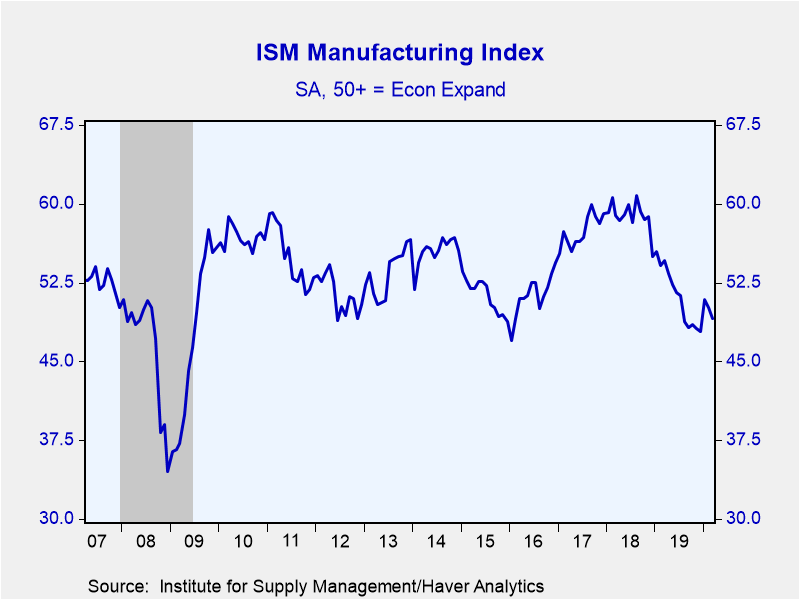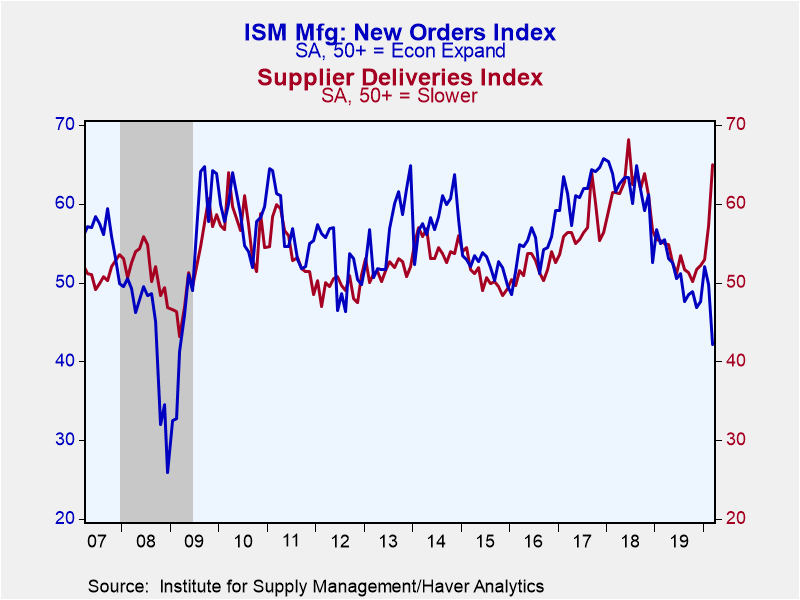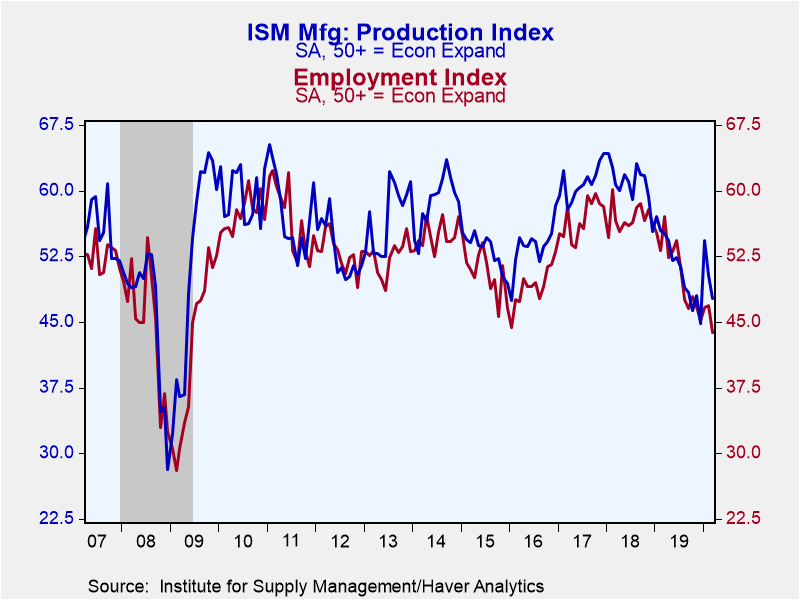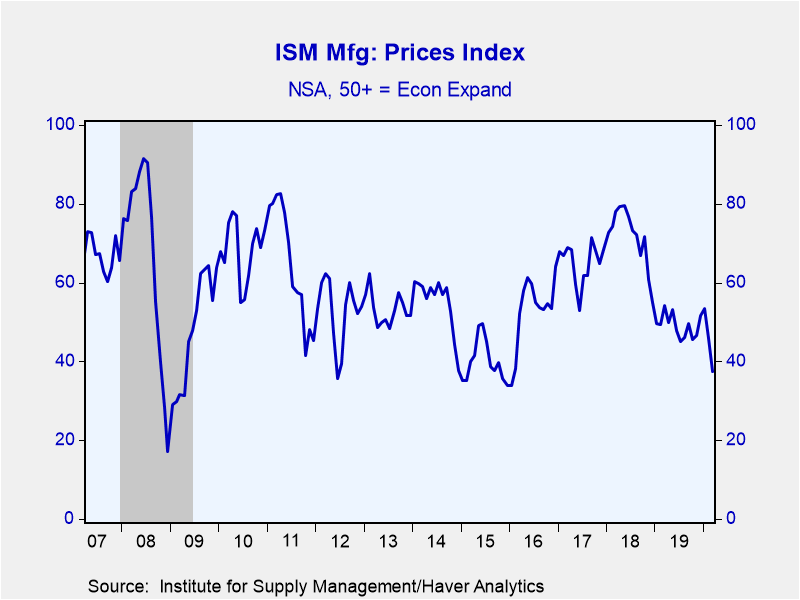 Global| Apr 01 2020
Global| Apr 01 2020ISM Manufacturing Index Weakens in March
by:Tom Moeller
|in:Economy in Brief
Summary
• Broad-based component declines led by fewer new orders. • Pricing power falls sharply. • Most readings move below the break-even level of 50. Activity in the factory sector weakened just slightly last month despite the onset of the [...]
• Broad-based component declines led by fewer new orders.
• Pricing power falls sharply.
• Most readings move below the break-even level of 50.
Activity in the factory sector weakened just slightly last month despite the onset of the coronavirus. The Institute for Supply Management (ISM) reported that its composite index of manufacturing sector activity for March fell to 49.1 after easing to 50.1 in February. A reading of 50.5 had been expected in the Action Economics Forecast Survey. During the last 15 years, there has been a 68% correlation between the composite index and the quarterly change in real GDP.
The new orders index fell to 42.2, its lowest level since March 2009. The production measure also fell sharply to 47.7, down versus the cycle high of 64.2 in January 2018.
Also declining to its lowest point since May 2009 was the employment measure to 43.8. Just nine percent (NSA) of respondents reported higher payrolls while 21% reported a decline. During the last 15 years, there has been 80% correlation between the employment index and the m/m change in factory sector payrolls.
The supplier delivery measure surged to 65.0 from 57.3, indicating the slowest product delivery speeds since June 2018. Holding fairly steady m/m at 46.9 was the inventory index, but that was down from 53.9 in August 2018.
The prices paid index declined sharply to 37.4 (NSA), its lowest point since January 2016. Only 12% of respondents reported higher prices while 37% reported a decline.
Other series in the ISM report indicated weakness. The export order measure fell to 46.6, the lowest point in six months and down from a high of 62.8 in February 2018. The import series fell to an expansion low of 42.1 and the order backlog measure fell to 45.9 from 50.4 twelve months earlier.
The ISM figures are diffusion indexes where a reading above 50 indicates expansion. The figures from the Institute for Supply Management can be found in Haver's USECON database; further detail is found in the SURVEYS database. The expectations number is available in Haver's AS1REPNA database.
| ISM Mfg (SA) | Mar | Feb | Jan | Mar'19 | 2019 | 2018 | 2017 |
|---|---|---|---|---|---|---|---|
| Composite Index | 49.1 | 50.1 | 50.9 | 54.6 | 51.2 | 58.9 | 57.4 |
| New Orders | 42.2 | 49.8 | 52.0 | 55.5 | 51.1 | 61.6 | 62.1 |
| Production | 47.7 | 50.3 | 54.3 | 55.1 | 51.2 | 60.9 | 60.9 |
| Employment | 43.8 | 46.9 | 46.6 | 57.1 | 50.9 | 56.9 | 56.8 |
| Supplier Deliveries | 65.0 | 57.3 | 52.9 | 54.9 | 52.9 | 62.0 | 56.8 |
| Inventories | 46.9 | 46.5 | 48.8 | 50.6 | 49.8 | 52.9 | 50.4 |
| Prices Paid Index (NSA) | 37.4 | 45.9 | 53.3 | 54.3 | 49.1 | 71.7 | 65.0 |
Tom Moeller
AuthorMore in Author Profile »Prior to joining Haver Analytics in 2000, Mr. Moeller worked as the Economist at Chancellor Capital Management from 1985 to 1999. There, he developed comprehensive economic forecasts and interpreted economic data for equity and fixed income portfolio managers. Also at Chancellor, Mr. Moeller worked as an equity analyst and was responsible for researching and rating companies in the economically sensitive automobile and housing industries for investment in Chancellor’s equity portfolio. Prior to joining Chancellor, Mr. Moeller was an Economist at Citibank from 1979 to 1984. He also analyzed pricing behavior in the metals industry for the Council on Wage and Price Stability in Washington, D.C. In 1999, Mr. Moeller received the award for most accurate forecast from the Forecasters' Club of New York. From 1990 to 1992 he was President of the New York Association for Business Economists. Mr. Moeller earned an M.B.A. in Finance from Fordham University, where he graduated in 1987. He holds a Bachelor of Arts in Economics from George Washington University.










